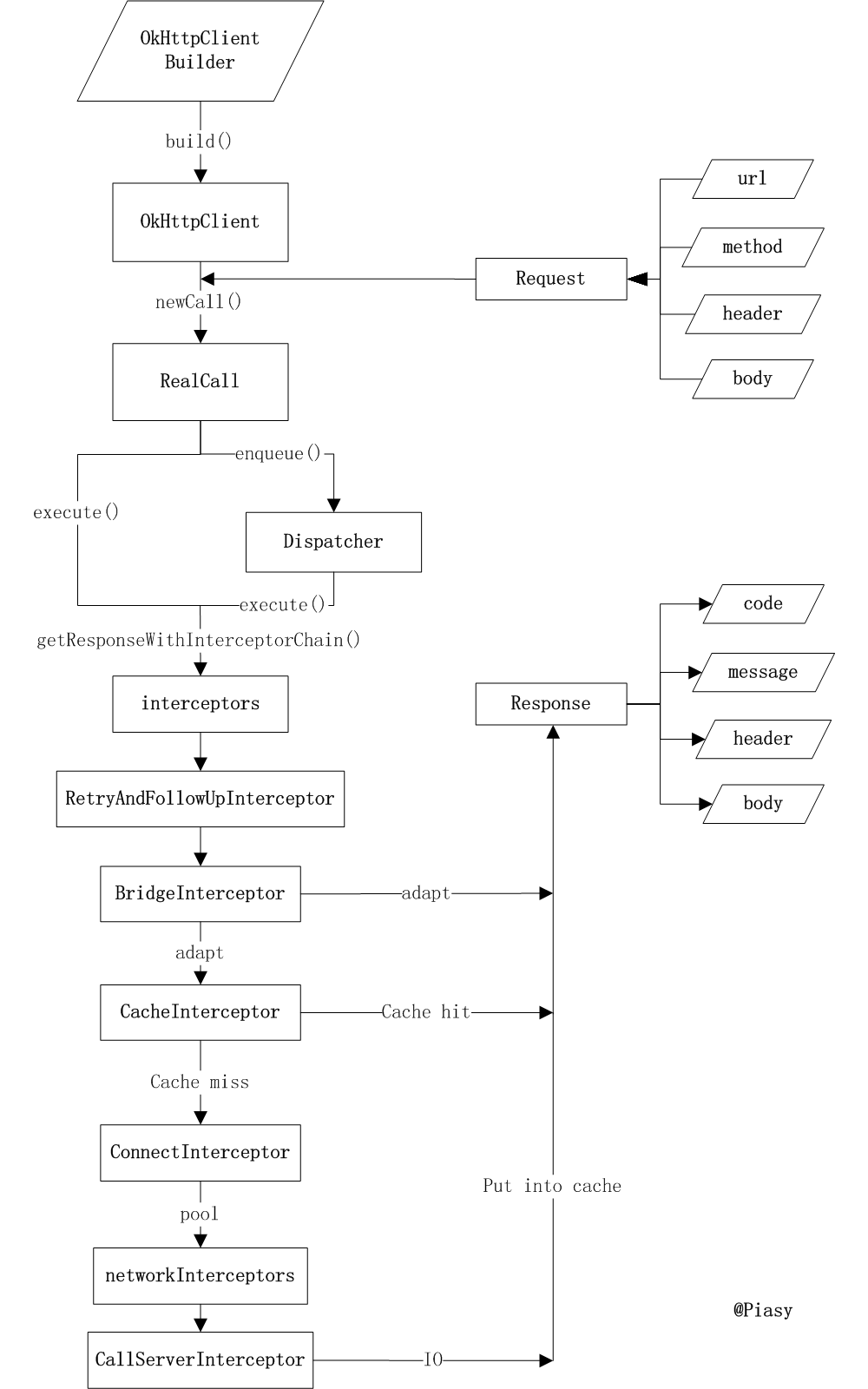Read the fuck source code
阅读源码吧
参考:
- Piasy: 拆轮子系列:拆 OkHttp
https://blog.piasy.com/2016/07/11/Understand-OkHttp/ - 郭孝星: Android 开源框架源码鉴赏:Okhttp
https://juejin.im/post/5a704ed05188255a8817f4c9 - BlackSwift: OkHttp3 源码分析 [任务队列]
https://www.jianshu.com/p/6637369d02e7 - mecury: OKHttp 源码解析
https://www.jianshu.com/p/27c1554b7fee - Frodo: OKHttp 源码解析
http://frodoking.github.io/2015/03/12/android-okhttp/ - 俞其荣: OkHttp 源码解析
http://yuqirong.me/2017/07/25/OkHttp%E6%BA%90%E7%A0%81%E8%A7%A3%E6%9E%90/ - 拉丁吴: 从 OKHttp 框架看代码设计
https://juejin.im/post/581311cabf22ec0068826aff - Tamic大白: OkHttp 3.x 源码解析之 Interceptor 拦截器
http://blog.csdn.net/sk719887916/article/details/74308343 - Cang_Wang: okhttp3 拦截器源码分析
https://juejin.im/post/5a94f680f265da4e710f8449
感谢前人的总结, 才能让我将源码阅读的那么顺利.
准备
okhttp是使用mavn构建的, 推荐先将github上的源代码clone下来, 然后使用IntelliJ IDEA导入之后阅读, 因为使用IDE在源码间跳转十分方便, 而且能很方便的查看某个变量或者某个方法在哪些地方被调用了.编译成功是这个样子的
使用实例
现在我们打开Android Studio,
导入依赖
1 | compile 'com.squareup.okhttp3:okhttp:3.10.0' |
使用okhttp写一个简单的请求
1 | OkHttpClient client = new OkHttpClient.Builder().build(); |
OkHttpClient
首先我们看OkHttpClient这个类.
client一般有两种创建方式
1 | OkHttpClient client = new OkHttpClient(); |
或者
1 | OkHttpClient client = new OkHttpClient.Builder().build(); |
我们看第一种的构造函数
1 | public OkHttpClient() { |
主要是将builder中的参数取出来.
我们去看看这个this(new Builder())中Builder()的构造函数
1 | public Builder() { |
可以看到是一堆默认配置, 注意这个Builder是OkHttpClient这个类中的一个内部类, 采用的当然是比较常见的Builder设计模式.
Request
这里我们顺带看一下Request的构建过程, 因为这个其实不是重点.
Request的构建一般是这样的
1 | Request request = new Request.Builder().url("https://www.toutiao.com/search/suggest/initial_page/").build(); |
点进去看一眼
1 | public Builder() { |
1 | public Builder url(String url) { |
看起来只是对url进行校验和赋值
Call
从这里开始就是重点了.
1 | Call call = client.newCall(request); |
我们调用这句产生一个Call对象
1 | call.execute(); |
然后调用这句发起一个同步的网络请求(按照从易到难的顺序, 我们先看同步请求)
在上面两句代码中, 我们先看Call对象是怎么产生的
1 | public Call newCall(Request request) { |
再跟进去
1 | /** |
可见这个Call对象其实是一个RealCall的对象, 值得注意的是RealCall现在有了client对象的引用.
因为要执行一个同步请求我们调用的是RealCall的execute()方法, 所以我们现在去看看这个方法
1 |
|
有些解读我已经在代码中做了注释.
好, 重点来了, 那就是getResponseWithInterceptorChain()这句代码, 看起来只是一句代码就得到了Response, 似乎十分轻松, 但是这其中其实要经历多个拦截器的过程.我们赶紧跟过去看看.
1 |
|
这里先是new了一个Interceptor的集合, 然后将各类Interceptor
- client中定义的Interceptor
- retryAndFollowUpInterceptor(负责失败重试以及重定向)
- BridgeInterceptor(负责把用户构造的请求转换为发送到服务器的请求、把服务器返回的响应转换为用户友好的响应)
- CacheInterceptor(负责读取缓存直接返回、更新缓存)
- ConnectInterceptor(负责和服务器建立连接)
- networkInterceptors(配置client时设置的interceptor)
- CallServerInterceptor(负责向服务器发送请求数据、从服务器读取响应数据)
全部加入到集合中
然后new了一个RealInterceptorChain, 注意在new这个对象的时候传入了Interceptor的集合和一个index(数值为0)
1 |
|
接着我们看到调用了这个chain的proceed(request)方法, Response也是由这个方法返回的, 我们跟过去看看
1 | /** |
因为调用的是第二个重载方法, 所以我们直接看第二个.
为了说明清楚, 我直接将第二个重载方法中的重点代码截图
还记得刚刚在RealCall中传入进来的index是多少吗?是0
在这里就会先构造一个RealIntercepterChain的对象(下一个要执行proceed(Request request)的对象), 类似于之前在RealCall中的getResponseWithInterceptorChain()
方法, 将interceptors和index(现在等于1)传进去, 然后从interceptors中取出第一个(index为0)interceptor, 调用interceptor的intercept(Chain chain)方法,
Response也是由这个方法返回的.
而这个intercept(Chain chain)方法是接口Interceptor中的一个抽象方法, 在Interceptor的各个实现类中会有各自不同的具体的重写
包括我们自己定义的Interceptor中的抽象方法, 比如我们有时候会这样写
1 | OkHttpClient okHttpClient = new OkHttpClient.Builder().addInterceptor(new Interceptor() { |
接下来我们以RetryAndFollowUpInterceptor举例子(按照顺序来, 假设client中没有添加任何inteceptor, 那么index为0的就是一个RetryAndFollowUpInterceptor)
, 看看它里面的intercept()方法
RetryAndFollowUpInterceptor
1 |
|
(⊙﹏⊙)b这个代码确实有点长, 我们直接看Response从哪里获取的, 我就直接说重点了, 看我截图
看到那个高亮的realChain了吗?就是我们刚刚在RealInterceptor中传进来的一个RealInterceptorChain对象, 这里又会去调用RealInterceptor的proceed()方法:
传入index + 1生成一个新的RealInterceptorChain对象, 从interceptors中取出下一个interceptor, 调用interceptor的intercept(Chain).
总结来说就是在RealInterceptorChain的proceed()方法中调用interceptor的intercept()方法, 在interceptor的intercept()方法中又调用RealInterceptorChain的proceed()方法…
来张图吧, 更清楚一些
这样一层层传递下去, 直到在CallServerInterceptor的intercept(Chain chain)才会结束并将Response返回.
而为了将这个事件传递下去, 我们自己写的interceptor在重写intercept()方法中, 必须返回chain.proceed(request), 否则就无法将其传递下去.你要是敢返回null就会报错.
异常是在RealInterceptorChain的这里抛出的
这种机制模式据称叫责任链模式, 可能okhttp的精髓也在于此了.View的事件分发其实也类似于此.
不过当然, 我这里说的都是”主线剧情”, 也就是网络请求一帆风顺的时候, 对于”支线剧情”错误的处理, 这里就不再展开赘述了.
CacheInterceptor
1 | public Response intercept(Chain chain) throws IOException { |
对于这块代码的解读基本上在注释里已经写清楚了.注意到一点, Okhttp只缓存get请求, 可以看一下HttpMethod.invalidatesCache()这个方法便知道
1 | public static boolean invalidatesCache(String method) { |
另外我还想知道okhttp的缓存策略是怎样的, 我们追踪cache.put(response)这个方法
最终追踪到的是一个Cache类里面
可以看到用的也是DiskLruCache, 我们知道DiskLruCache是需要指定一个缓存目录的, 然后我翻遍了源码也没有找到默认的文件保存路径, 可见这是需要我们自己指定的, 像这样
1 | OkHttpClient client = new OkHttpClient |
ConnectInterceptor
现在我们看看ConnectInterceptor, 它的主要作用是建立连接
1 | public Response intercept(Chain chain) throws IOException { |
这里调用了 streamAllocation.newStream 创建了一个 HttpCodec 的对象
而 HttpCodec 是一个抽象类,其实现类分别是 Http1Codec 和 Http2Codec 。相对应的就是 HTTP/1.1 和 HTTP/2.0。在 Http1Codec 中,它利用 Okio 对 Socket 的读写操作进行封装
我们来看下streamAllocation.newStream(client, chain, doExtensiveHealthChecks)的代码
1 | public HttpCodec newStream( |
而创建 HttpCodec 对象的过程涉及到 StreamAllocation、RealConnection,代码较长,这里就不展开,这个过程概括来说,就是在连接池中找到一个可用的 RealConnection,再利用 RealConnection 的输入输出(BufferedSource 和 BufferedSink)创建 HttpCodec 对象,供后续步骤使用。
CallServerInterceptor
CallServerInterceptor是集合interceptors中的最后一个interceptor, 如果前面都没有return Response的话, 在这里就应该将Response返回了, 所以在这里你是搜不到chain.proceed()方法的.
1 | public Response intercept(Chain chain) throws IOException { |
这里因为我对底层的网络协议并不是太熟悉, 就直接引用别人的结论了.
这里我们可以看到,核心工作都由 HttpCodec 对象完成,而 HttpCodec 实际上利用的是 Okio,而 Okio 实际上还是用的 Socket,所以没什么神秘的,只不过一层套一层,层数有点多。
异步的网络请求
在实际开发中我们用的最多的其实还是异步的请求方式
1 |
|
这里还有一个很重要的参与者Dispatcher, 中文意思调度器, 它的源码我们一会儿再说.现在我们跟过去看看它的enqueue()方法
1 | synchronized void enqueue(AsyncCall call) { |
如果当前还能执行一个并发请求,那就将这个请求加入 runningAsyncCalls 队列, 然后立即执行,否则加入 readyAsyncCalls 队列.
这里的executorService()返回的其实是一个线程池对象, 这里的call对象是一个AsyncCall对象, 那么这个AsyncCall类一定是实现了Runnable接口, 重写了run()方法, 那我们去看看这个AsyncCall类的run()方法是怎样的.
这是我们发现AsyncCall是继承了NamedRunnable这个抽象类的, NamedRunnable替AsyncCall实现了run()方法
1 | public abstract class NamedRunnable implements Runnable { |
但是在重写的run()方法中调用了抽象方法execute(), 所以这个execure()方法就需要AsyncCall自己去实现了, 我们去看一下
1 | protected void execute() { |
在这里我们又看到之前看到的getResponseWithInterceptorChain()
方法, 刚才已经分析过了.并且在这里还能看到我们传入进去的responseCallback对象在这里被调用了, 返回请求失败或者response.在finally中也就是请求结束之后, 会调用Dispatcher的finished()方法, 我们去看看
1 | void finished(AsyncCall call) { |
可见在请求结束之后, 会将readyAsyncCalls 队列中的call对象取出来, 加入到runningAsyncCalls 队列中, 然后立即执行.
Dispatcher
Dispatcher也是阅读okhttp源码时不可忽略的一个类.记得上面在RealCall的enqueue(Callback)方法中, 调用了Dispatcher的enqueue()方法, 现在我们去看看这个类
1 |
|
可以看到Dispatcher内部维护了三个双端队列:
- readyAsyncCalls:准备运行的异步请求
- runningAsyncCalls:正在运行的异步请求
- runningSyncCalls:正在运行的同步请求
maxRequests是最大同时请求数量, 大小是64.
我们再看那个executorService, 那个线程池的产生方式.到这里就不得不科普一下线程池的知识了
可以看到okhttp使用的是6个参数的构造函数: corePoolSize是0, maximumPoolSize是无限制, keepAliveTime是60秒, workQueue是一个泛型为runnable是SynchronousQueue, threadFractory是一个自定义的ThreadFactory.下面说说这几个参数的含义:
- corePoolSize -> 该线程池中核心线程数最大值
核心线程:在创建完线程池之后,核心线程先不创建,在接到任务之后创建核心线程。并且会一直存在于线程池中(即使这个线程啥都不干),有任务要执行时,如果核心线程没有被占用,会优先用核心线程执行任务。数量一般情况下设置为 CPU 核数的二倍即可。默认情况下,假如核心线程被创建了, 即使核心线程没有任务在执行它会一直存活 - maximumPoolSize -> 该线程池中线程总数最大值
非核心线程:简单理解,即核心线程都被占用,但还有任务要做,就创建非核心线程 - keepAliveTime -> 非核心线程闲置超时时长
这个参数可以理解为,任务少,但池中线程多,非核心线程不能白养着,超过这个时间不工作的就会被干掉,但是核心线程会保留。 - TimeUnit -> keepAliveTime 的单位
- BlockingQueue workQueue -> 线程池中的任务队列
默认情况下,任务进来之后先分配给核心线程执行,核心线程如果都被占用,并不会立刻开启非核心线程执行任务,而是将任务插入任务队列等待执行,核心线程会从任务队列取任务来执行,任务队列可以设置最大值,一旦插入的任务足够多,达到最大值,才会创建非核心线程执行任务。
常见的 workQueue 有四种:SynchronousQueue、LinkedBlockingQueue、ArrayBlockingQueue、DelayQueue
因篇幅有限, 我这里只说一下SynchronousQueue
SynchronousQueue:这个队列接收到任务的时候,会直接提交给线程处理,而不保留它,如果所有线程都在工作怎么办?那就新建一个线程来处理这个任务!所以为了保证不出现 < 线程数达到了maximumPoolSize而不能新建线程 > 的错误,使用这个类型队列的时候,maximumPoolSize一般指定成 Integer.MAX_VALUE,即无限大. - ThreadFactory threadFactory -> 创建线程的工厂
可以用线程工厂给每个创建出来的线程设置名字。一般情况下无须设置该参数。
可见这里创建的是一个核心线程为0的线程池,它不保留任何核心线程,随时创建更多的线程数,当线程空闲时只能活60秒. 创建线程使用的是一个叫做 “OkHttp Dispatcher” 的线程工厂。也就是说,在实际运行中,当收到 10 个并发请求时,线程池会创建十个线程,当工作完成后,线程池会在 60s 后相继关闭所有线程。以上关于线程池的参考自
别再说你不懂线程池——做个优雅的攻城狮
Android 线程池得要这么用
Android 线程和线程池一篇就够了
addNetworkInterceptor和addInterceptor的区别
关于看到addNetworkInterceptor和addInterceptor有人是这样说的
addNetworkInterceptor添加的是网络拦截器,他会在在request和resposne是分别被调用一次
addinterceptor添加的是aplication拦截器,他只会在response被调用一次
然而事实真的是这样吗?我们写代码测试一下
1 | OkHttpClient okHttpClient = new OkHttpClient.Builder().addInterceptor(new Interceptor() { |
我们在intercept和netWorkInterceptor里面分别打印了日志, 然后用了今日头条的一个api测试了一下
结果看到, 发送了两次请求, interceptor和netWorkInterceptor中都分别只调用了一次, 这是不是说网上的说法就是错误的呢?别急, 我们再换一个okhttp官方wiki中的api测试一下
这一次, 我们发现addNetWorkInterceptor中的intercept()方法被调用了两次?这是怎么回事呢?我们打个断点追踪一下堆栈
经过一番排查最终发现是在RetryAndFollowUpInterceptor的intercept()方法里
1 | public Response intercept(Chain chain) throws IOException { |
需要注意的地方我已经在代码里加了注释.这里面有一个while循环, 只有follwUpRequest为null时才会return response跳出循环, 不信打个断点看一下
可以发现这个request重定向到了http://publicobject.com/helloworld.txt地址, 所以while循环里面的代码才会执行两次, 因此也导致RetryAndFollowUpInterceptor后面的拦截器也被调用了两次, 而我们用的今日头条的那个api是没有重定向的, 所以才会只执行一次.其实官方wifi里面也已经说得很清楚了
所以阅读原生资料很重要, 如果英文不好, 推荐看这篇哟
OkHttp 3.x 源码解析之 Interceptor 拦截器
总结
其实还有一些细节没分析, 比如连接池, 具体的底层网络连接等等, 但是我有点累了, 有机会再补充吧. 最后盗用别人的一张完整的流程图回顾一下吧.
